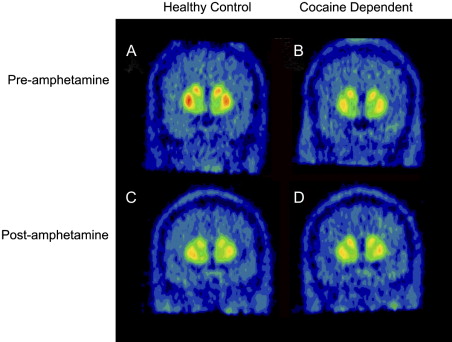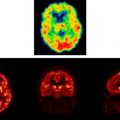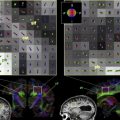Animal models of abuse and dependence have long suggested that chronic drug and alcohol exposure is associated with marked changes in neurochemistry. The development of PET and SPECT imaging now allows investigation of the effects of addiction on the neurochemistry of the human brain. This article reviews the literature of radiochemical imaging in cocaine, alcohol, heroin, methamphetamine, MDMA, and ketamine abuse and dependence.
Positron emission tomography (PET) and single photon emission computed tomography (SPECT) use radiotracers to image molecular targets in the human brain. These techniques have been applied over the last decade to study addiction and provide an important body of knowledge about the neurochemical alterations associated with drug and alcohol dependence.
Although the techniques of PET and SPECT molecular imaging have been reviewed elsewhere, we briefly overview the concepts that are needed to interpret these studies. The PET radiotracers most frequently used in substance abuse research are those that label the dopamine type 2/3 (D 2/3 ) receptors of the striatum, such as the antagonists 18 F-N-methylspiroperidol (labeled with a positron-emitting fluorine) and 11 C-raclopride (labeled with a positron emitting carbon). Other radiotracers that are available include those that label the dopamine transporter, serotonin transporter and receptors, GABA receptor, and opioid receptors. The outcome measure in PET studies is termed receptor availability or binding potential (BP), which is equivalent in pharmacologic terms to the product of receptor density and affinity of the radiotracer for the receptor.
In addition to the BP, PET and the radiotracer 11 C-raclopride can also be used to measure striatal dopamine transmission. 11 C-raclopride binding is sensitive to the endogenous dopamine in the brain: increases in extracellular dopamine (produced with a psychostimulant such as methylphenidate or amphetamine) decrease 11 C-raclopride binding ( Fig. 1 ). In the same individual, therefore, a comparison of baseline (ie, pre-stimulant) and post-stimulant BP provides an indirect measure of dopamine transmission. The mechanism underlying the decrease in radiotracer binding is believed to be competition between extracellular dopamine and the radiotracer for the D 2/3 receptor, although other mechanisms, such as receptor affinity state, internalization, or polymerization may also play a critical role .

Several PET studies in human drug- and alcohol-dependent subjects have been performed using these techniques. Most of these studies have measured dopamine receptors and dopamine release in the striatum, and thus are the focus of this review. In addition, most PET studies of addiction have been performed in cocaine-dependent subjects, so the authors’ review of the literature begins with this disorder.
Cocaine dependence
Dopamine D 2/3 receptors and dopamine transmission
As early as 1990, studies with PET have shown that cocaine addiction is associated with alterations in dopamine receptors. Using PET and 18 F-N-methylspiroperidol, Volkow and colleagues demonstrated that cocaine dependence was associated with a decrease in D 2/3 receptor availability in the striatum compared with healthy control subjects. Subsequent studies performed using similar methods have consistently shown decreases of 11% to 15% in striatal D 2/3 receptors in this same population using 11 C-raclopride . In addition, Volkow and colleagues reported that the decrease in D 2/3 receptors persisted in a group of cocaine-dependent subjects rescanned after 3 months of inpatient rehabilitation.
Although this decrease in D 2/3 receptor BP was first measured in cocaine dependence, a similar decrease has been seen in several other addictions, such as heroin addiction , alcohol dependence , methamphetamine abuse , and even obesity . These findings suggest that low D 2/3 receptor availability might be a general risk factor for addiction, and it has been hypothesized that low D 2/3 receptor BP is associated with a low sensitivity to naturally occurring reinforcers and a propensity to depend on pharmacologic stimulation to experience reward .
In addition to baseline D 2/3 receptor BP, PET studies have been used to investigate dopamine transmission in cocaine dependence. Volkow and colleagues demonstrated that cocaine dependence was associated with less displacement of 11 C-raclopride following methylphenidate (0.5 mg/kg IV) compared with control subjects, suggesting that cocaine dependence is associated with a loss of dopamine transmission. Malison and colleagues reported similar results using SPECT and 123 I-IBZM (which also labels the D 2/3 receptor) using amphetamine (0.3 mg/kg IV) to increase endogenous dopamine. Both studies thus suggest that cocaine dependence is associated with a decrease in presynaptic dopamine function. This hypothesis is supported by a PET study showing that cocaine-dependent subjects (abstinent 11–30 days) had lower uptake of the levodopa analog 6- 18 F-fluoro-L-DOPA compared with healthy control subjects, suggesting that cocaine dependence is associated with a decrease in the dopamine stores of the presynaptic neuron .
Because of the resolution of PET (and SPECT) cameras, these studies measured dopamine receptors and dopamine transmission in the striatum as a whole. In other words, the resolution did not allow for differentiation of the signal emitted from the caudate, putamen, and ventral striatum. With a higher-resolution device, the substructures of the striatum can be measured separately . The authors recently published two studies in human cocaine-dependent subjects and matched healthy control subjects using a high-resolution PET camera : one study measured D 2/3 receptors and the other measured dopamine transmission using 11 C-raclopride and a psychostimulant challenge (amphetamine 0.3 mg/kg IV). In these studies, the striatum was subdivided into the ventral striatum (which contains the nucleus accumbens), associative striatum (which includes the caudate and anterior putamen and is largely involved in cognition), and the sensorimotor striatum (which contains the posterior putamen and receives input from motor and premotor areas).
The results of the authors’ study investigating D 2/3 receptor BP showed a significant reduction in all three striatal subdivisions in the cocaine-dependent subjects (decreases of 15% in the limbic and associative striatum and 17% in the sensorimotor striatum) compared with the healthy control subjects . In the study of dopamine transmission, cocaine dependence was associated with a marked reduction in amphetamine-induced 11 C-raclopride displacement in each of the functional subregions . These studies thus demonstrate that in cocaine dependence the deficits in dopamine neurotransmission are similar across the ventral and dorsal subdivisions of the striatum.
Functional significance of low D 2/3 receptor binding in cocaine dependence
The observation of decreased D 2/3 receptor BP in cocaine-dependent subjects raises the question of whether this finding may serve as a risk factor for cocaine dependence. In fact, a series of studies have suggested that a high level of D 2/3 BP may be protective against developing dependence. A recent study reported that nonaddicted siblings of cocaine abusers had a higher D 2/3 receptor BP compared with their cocaine-dependent siblings . Because the siblings presumably had similar risk factors for dependence, this finding suggests that elevated D 2/3 receptor BP may be a neurobiologic marker of resilience. Volkow and colleagues reported that high striatal D 2/3 receptor BP in healthy control subjects was predictive of an unpleasant experience following administration of the psychostimulant methylphenidate, and conversely, lower D 2/3 BP was associated with a pleasurable experience. Insofar as a pleasurable experience with a drug indicates a risk for substance abuse, these results indicate that high D 2/3 receptor BP may be protective.
The authors recently investigated the correlation between low D 2/3 receptor BP and the choice to self-administer cocaine in human cocaine-dependent subjects . As described, these subjects had a decrease in D 2/3 receptor availability throughout the subdivisions of the striatum compared with a group of matched healthy control subjects. Following the PET scans, the cocaine-dependent volunteers underwent cocaine self-administration sessions in which participants were given the choice between doses of smoked cocaine and monetary vouchers. This study showed no correlation between D 2/3 receptor BP and the positive effects of cocaine or the choice to self-administer cocaine . Although low D 2/3 receptor availability might be related to a pleasurable psychostimulant experience in control subjects, this phenomenon thus does not seem to be present in addicted subjects. One way to interpret these data is that low D 2/3 receptor BP may correlate with a positive response to a psychostimulant and is thus a risk factor for cocaine dependence. Of the individuals who become addicted (ie, choose to self-administer cocaine), most therefore have lower than average D 2/3 receptor binding. Within the cohort of cocaine abusers, however, low D 2/3 receptor BP does not predict drug-seeking behavior.
Behavior and dopamine transmission
Given the consistent finding of low dopamine transmission in cocaine dependence, the authors recently completed a study designed to investigate the correlation between drug-seeking behavior and blunted dopamine transmission. As described, cocaine dependence was associated with a decrease in amphetamine-induced 11 C-raclopride displacement compared with healthy control subjects . Following the scans, the cocaine-dependent participants were given the choice between smoked cocaine and monetary vouchers in self-administration sessions. The results of this study showed that blunted dopamine transmission in the ventral striatum was predictive of the choice for cocaine over the choice for money . The self-administration sessions were developed as a laboratory model of relapse based on animal studies showing that a priming dose of cocaine reinstates cocaine self-administration . This finding thus suggests that cocaine-dependent subjects who are the most vulnerable to relapse are those with the lowest presynaptic dopamine function. This is in agreement with the hypothesis put forth by Melis and colleagues , who have proposed that a hypodopaminergic state in addiction is associated with a decreased interest in nondrug-related cues and excessive interest in drugs of abuse.
Imaging cue-induced craving in cocaine dependence
Two recent studies have investigated the effect of drug-related cues on 11 C-raclopride binding in cocaine dependence . Both studies used a video of persons using cocaine compared with a neutral video (nature scenes). Volkow and colleagues showed a decrease in 11 C-raclopride BP in the dorsal striatum (caudate and putamen) following the cocaine video compared with the neutral video. Wong and colleagues showed a significant decrease in BP in the left anterior putamen in the cocaine subjects who craved cocaine, whereas there was no significant change in cocaine abusers who did not crave cocaine. In both studies, the magnitude of 11 C-raclopride displacement correlated with craving for cocaine.
In addition, Volkow and colleagues showed that cue-induced changes in dopamine correlated with the severity of addiction, such that greater dopamine release in the dorsal striatum correlated with higher scores of severity. This finding suggests that dopamine release in response to a cue correlates with craving for drug and might thus correlate with a greater risk for relapse. In contrast, the data described demonstrated that subjects with the lowest amphetamine-induced dopamine release are more likely to self-administer cocaine, such that greater deficits in dopamine release may indicate risk for relapse. The reason for this difference is not clear, although it has been suggested that set-shifting depends on dopamine transmission in the dorsal striatum and reversal learning is mediated by dopamine in the ventral striatum . Dopamine transmission in the ventral versus dorsal striatum may thus play a critical role in relapse.
Cocaine dependence and the dopamine transporter
A study using SPECT and the dopamine transporter (DAT) radiotracer 123 I-beta-CIT reported a 20% increase in DAT availability in cocaine abusers who had been abstinent for only 96 hours . Two studies using the radiotracer 11 C-cocaine to label the DAT, however, showed no difference in BP between healthy control subjects and cocaine abusers who had been abstinent 5 ± 8 days or 42 ± 7 days . Together these studies suggest that the DAT is elevated in very early abstinence but does not seem to differ from control subjects after this time point.
Imaging studies of cocaine dependence and other neurotransmitters
Despite that cocaine directly affects the serotonin system and that altering serotonin transmission in human subjects modulates the subjective effects of cocaine , only one SPECT study has been performed to measure the serotonin transporter. This study showed that the transporter was increased in the brainstem in cocaine abusers who had been abstinent for 3.7 ± 3.8 days . The duration of abstinence was brief, and it is not known if this elevation is long-lasting.
Two PET studies of cocaine dependence using the μ-agonist receptor radiotracer 11 C-carfentanil have been performed. The first of these imaged cocaine-dependent subjects after 1 to 4 days of abstinence and again at 4 weeks of abstinence compared with control subjects . μ Receptor BP was increased in the anterior cingulate, frontal and temporal cortex, caudate, and thalamus in the cocaine abusers in early abstinence and increased in the cingulate, frontal cortex, caudate, and thalamus after 4 weeks of abstinence. In a later study, this same group measured μ receptor BP in a group of cocaine abusers at three time points: after 1 day, 1 week, and 12 weeks of abstinence . The results showed that μ receptor BP was increased in the anterior cingulate, frontal cortex, and temporal cortex after 1 day of abstinence and remained elevated in the anterior cingulate and anterior frontal cortex up to 12 weeks . In both of these studies, μ receptor binding positively correlated with self-reports of craving for cocaine, suggesting that modulation of the endogenous opioid system may play a role in cocaine addiction and relapse.
Stay updated, free articles. Join our Telegram channel

Full access? Get Clinical Tree





